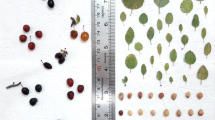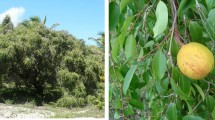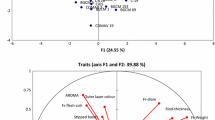Abstract
The landraces of Lagenaria siceraria in Turkey show great diversity for morphologic traits, particularly in fruit size and shape even though Turkey is not centre of genetic diversity for L. siceraria. In Turkey, L. siceraria is used as food, musical instruments and containers, according to the type and shape of their fruits. Its diversity has been gradually declining over the last 25 years. With the aim of assessing variations in plant, fruit and seed morphology among the L. siceraria landraces, 15 field trips for collection of germplasm to southern parts of Turkey (Mediterranean region) were carried out in the period of 2003–2004. The study also aimed at developing a representative core collection of the material to guide future studies and uses concerning its existing genetic diversity in Turkey. A total of 182 accessions (fruits and/or seeds) were collected. The seeds from all the sample material were sown in green house conditions at the experimental station of the Faculty of Agriculture of the Mustafa Kemal University in Hatay (Antakya), (36° 18′ 22′′ N, 36° 13′ 33′′ E, 82 m). In the spring of 2004, 162 out of the 182 sown seeds germinated and developed into viable seedlings. These were further transplanted in the field in 10 replicates. The morpho-agronomic characterization was carried out following the international standards for crop descriptors set by Bioversity International. The data were subject to both descriptive statistics and multivariate analysis by Principle Component Analysis. The descriptive statistics revealed that the whole collection exhibits a great deal of morphological diversity and that the subset core collection represents most of the variability. The first three principle components, calculated by using six quantitative traits, explained 26%, 21% and 17% (a total of 64%) of the total variation. Among the studied accessions, no apparently distinct patterns such as geographical origin were detected. This may suggest that the accessions have been introduced to Turkey from multiple locations and/or their diversity had been distributed almost evenly across the Mediterranean region of this country. Based on our results from the morphological characterization, 30 genotypes were selected to develop a subgroup (core) collection in order to represent most of the genetic diversity of all accessions. The work presented here is the first report about morphological characterization of Turkish L. siceraria germplasm.





Similar content being viewed by others
References
Ashita E (1927) Grafting of watermelons (in Japanese). Korea (Chosun) Agric Newsl 1–9
Bioversity International (2007) Guidelines for the development of crop descriptor lists. Bioversity Technical Bulletin Series. Bioversity International, Rome, Italy. xii+72 p. ISBN: 978-92-9043-792-1
Bose TK, Som MG (1986) Vegetable crops in India. Publ. B. Mitra, Naya Prokash, 206 Bidhan Sarani, Calcutta 700 006, India, 1664 p
Decker-Walters D, Staub J, López-Sésé A, Nakata E (2001) Diversity in landraces and cultivars of bottle gourd (Lagenaria siceraria; Cucurbitaceae) as assessed by random amplified polymorphic DNA. Genet Resour Crop Evol 48:369–380
Decker-Walters DS, Wilkins-Ellert M, Chung S, Staub JE (2004) Discovery and genetic assessment of wild bottle gourd [Lagenaria siceraria; (Mol.) Standley; Cucurbitaceae] from Zimbabwe. Econ Bot 58:501–508
GBIF (2007) Catalogue of Life: Annual Checklist, Species 2000 (accessed through GBIF data portal, http://www.data.gbif.org/datasets/resource/1542, 18-01-2008
Hammer K, Knüpffer H, Laghetti G, Perrino P (1999) Seeds from the past. A catalogue of crop germplasm in central and north Italy. CNR, Instituto del Germoplasma, Bari, 254 pp
Harris DR (1967) New light on plant domestication and the origins of agriculture: a review. Geogr Rev 57:90–107
Herklots GAC (1972) Vegetables in South East Asia. George Allen and Unwin Ltd, London
Kılıc S (1999) Soil survey and land use planning of Antakya district by using remote sensing/GIS techniques. Ph.D. thesis, Çukurova University, Inst. Natural and Applied Sci., Adana-Turkey, 214 p
Lee JM (1994) Cultivation of grafted vegetables I. Current status, grafting methods and benefits. HortScience 29:235–239
Manandhar NP (2002) Plants and people of Nepal. Timber Press, Oregon. ISBN: 0-88192-527-6
McGuire RG (1992) Reporting of objective color measurement. HortScience 27:1254–1255
Moerman D (1998) Native American ethnobotany. Timber Press, Oregon
Morimoto Y, Maundu P, Fujimaki H, Morishima H (2005) Diversity of landraces of the white-flowered gourd (Lagenaria siceraria) and its wild relatives in Kenya: fruit and seed morphology. Genet Resour Crop Evol 52:737–747
Oda M (1995) New grafting methods for fruit—bearing vegetables in Japan. JARQ 29:187–198
Sakar M (2004) Characterization of bottle gourd (Lagenaria siceraria) genotypes collected from Mediterranean region. University of Mustafa Kemal, Institute of Natural and Applied Science. Master Thesis, Hatay, 74 p
SAS Institute (2005) SAS Online Doc, Version 8. SAS Inst., Cary, NC
Sensoy S, Buyukalaca S, Abak K (2007) Evaluation of genetic diversity in Turkish melons (Cucumis melo L.) based on phenotypic characters and RAPD markers. Genet Resour Crop Evol 54:1351–1365
Tan A, Tan AS (1998) Database management systems for conservation of genetic diversity in Turkey. In: Zencirci N, Kaya Z, Anikster Y, Adams WT (eds) The proceeding of international symposium on in situ conservation of plant genetic diversity, Antalya, Turkey, 4–8 November, 1996
Van Hintum TJL, Brown AHD, Spillane C, Hodgkin T (2000) Core collections of plant genetic resources. IPGRI Technical Bulletin No. 3. International Plant Genetic Resources Institute, Rome, Italy
Whitaker TW (1971) Endemism and pre-Columbian migration of bottle gourd, Lagenaria siceraria (Mol.) Standl. In: Riley CL, Kelley JC, Pennington CW, Runds RL (eds) Man across the sea. University of Texas Pres, Austin, pp 78–218
Yetisir H, Sarı N (2003) Effect of different rootstock on plant growth, yield and quality of watermelon. Aust J Exp Agric 43:1269–1274
Acknowledgements
We gratefully acknowledge the financial supports from the Scientific and Technological Council of Turkey (TOGTAG-3216) and Mustafa Kemal University.
Author information
Authors and Affiliations
Corresponding author
Rights and permissions
About this article
Cite this article
Yetişir, H., Şakar, M. & Serçe, S. Collection and morphological characterization of Lagenaria siceraria germplasm from the Mediterranean region of Turkey. Genet Resour Crop Evol 55, 1257–1266 (2008). https://doi.org/10.1007/s10722-008-9325-y
Received:
Accepted:
Published:
Issue Date:
DOI: https://doi.org/10.1007/s10722-008-9325-y




